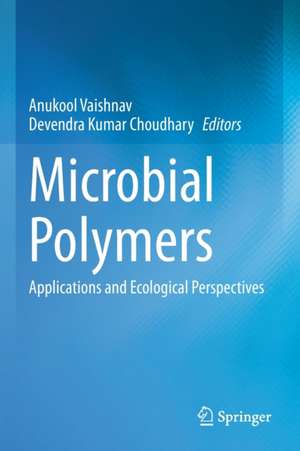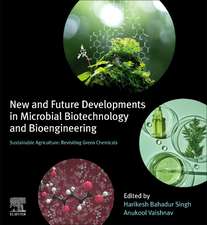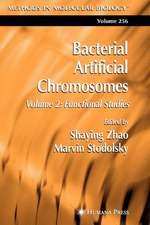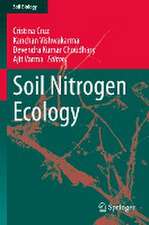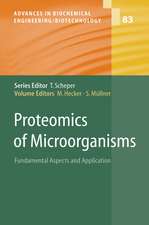Microbial Polymers: Applications and Ecological Perspectives
Editat de Anukool Vaishnav, Devendra Kumar Choudharyen Limba Engleză Paperback – 5 mai 2022
This compilation of scientific chapters on principles and practices of microbial polymers fosters the knowledge transfer among scientific communities, industries, and microbiologist and serves students, academicians, researchers for a better understanding of the nature of microbial polymers and application procedure for sustainable ecosystem
| Toate formatele și edițiile | Preț | Express |
|---|---|---|
| Paperback (1) | 1327.42 lei 17-23 zile | +111.52 lei 6-10 zile |
| Springer Nature Singapore – 5 mai 2022 | 1327.42 lei 17-23 zile | +111.52 lei 6-10 zile |
| Hardback (1) | 1572.30 lei 6-8 săpt. | |
| Springer Nature Singapore – 4 mai 2021 | 1572.30 lei 6-8 săpt. |
Preț: 1327.42 lei
Preț vechi: 1746.61 lei
-24% Nou
Puncte Express: 1991
Preț estimativ în valută:
254.04€ • 262.43$ • 211.42£
254.04€ • 262.43$ • 211.42£
Carte disponibilă
Livrare economică 01-07 martie
Livrare express 18-22 februarie pentru 121.51 lei
Preluare comenzi: 021 569.72.76
Specificații
ISBN-13: 9789811600470
ISBN-10: 9811600473
Ilustrații: XI, 710 p. 134 illus., 73 illus. in color.
Dimensiuni: 155 x 235 mm
Greutate: 1.08 kg
Ediția:1st ed. 2021
Editura: Springer Nature Singapore
Colecția Springer
Locul publicării:Singapore, Singapore
ISBN-10: 9811600473
Ilustrații: XI, 710 p. 134 illus., 73 illus. in color.
Dimensiuni: 155 x 235 mm
Greutate: 1.08 kg
Ediția:1st ed. 2021
Editura: Springer Nature Singapore
Colecția Springer
Locul publicării:Singapore, Singapore
Cuprins
Chapter 1. The production and applications of microbial derived polyhydroxy butyrates.- Chapter 2. Fungal exopolysaccharides: types, production and application.- Chapter 3. Isolation and purification of microbial exopolysaccharides and their industrial applications.- Chapter 4. A review on properties and application of xanthan gum.- Chapter 5. Biosynthesis and characterization of poly-(3)-hydroxyalkanoic acid by Bacillus megaterium SF4 using different carbohydrates.- Chapter 6. Mushroom mycelia-based material: an environmental friendly alternative to synthetic packaging.- Chapter 7. An overview of microbial derived polyhydroxy butyrate (PHB): production and characterization.- Chapter 8. Insight of Biopolymers and applications of Polyhydroxyalkanoates.- Chapter 9. Microbial pigments and their application.- Chapter 10. Extracellular polymeric substances from agriculturally important microorganisms.- Chapter 11. Significance of bacterial polyhydroxy alkanoates in rhizosphere.- Chapter 12. Role of microbial biofilms in agriculture: perspectives on plant and soil health.- Chapter 13. Biological soil crusts to keep soil alive, rehabilitate degraded soil, and develop soil habitats.- Chapter 14. Fungal chitosan :the importance and beneficiation of this biopolymer in industrial and agriculture process.- Chapter 15. Role of microbial extracellular polymeric substances in soil fertility.- Chapter 16. Microbes derived exopolysaccharides play role in salt stress alleviation in plants.- Chapter 17. Microbial exopolysaccharides: structure and therapeutic properties.- Chapter 18. Microbial biopolymers: pharmaceutical, medical & biotechnological applications.- Chapter 19. Mycobacterium Biofilms synthesis, ultra structure and their perspectives in drug tolerance, environment and medicine.- Chapter 20. A comprehensive review on different microbial derived pigments and their multipurpose activities.- Chapter 21. Microbial polysaccharides with potential industrial applications: diversity, synthesis and their applications.- Chapter 22. Eco friendly microbial biopolymers: recent development, biodegradation and applications.- Chapter 23. Microbial biopolymers as an alternative construction binder.- Chapter 24. Genetic engineering approaches for high end application of biopolymers:Advances and future prospects.- Chapter 25. Microbial pigments: secondary metabolites with multifaceted roles.- Chapter 26. Bio-fermentative production of xanthan gum biopolymer and its application in petroleum sector.- Chapter 27. A comparative study on biodegradable packaging materials: current status and future prospects.- Chapter 28. Environmental implications of microbial bioplastics for a sustainable future.
Notă biografică
Dr. Anukool Vaishnav: Anukool Vaishnav is working as an Assistant professor in Department of Biotechnology, GLA University, Mathura. He operated SERB-National Postdoctoral Fellowship (NPDF) project as a Principal Investigator at Department of Mycology and Plant Pathology, Institute of Agricultural Sciences, Banaras Hindu University, Varanasi, India. He has 7 years of research experience in Agriculture Microbiology. His research is mainly focuses on microbial mediated plant protection against biotic and abiotic stress, characterization of signaling molecules and secondary metabolites (soluble and VOCs) in plant holobionts. As an active researcher, he has published more than 20 research and review articles along with 13 book chapters for reputed journals and edited books. He has filed 9 Indian patents in association with his research group. He is an editorial member of Current Genomics Journal published by Bentham Science. He has been awarded with Young Scientist Award from reputed societies.
Dr. Devendra Kumar Choudhary: Dr. Choudhary is selected member-National Academy of Sciences, India (NASI) and shows his presence at Amity University Uttar Pradesh, Noida. Recently he was associated with PDM and worked as Professor (Ad hoc) for three months. He is active researcher and operated major projects with worth amount 10 million sponsored by DBT, DST and SERB, New Delhi, India, as principal investigator and co-investigator. He has involved and contributed in NAAS policy paper number 36 in the year 2006. He has published more than 80 research/review articles along with several book chapters for reputed journals and edited books (Springer, Elsevier and Taylor Francis/Wiley-Blackwell). He has supervised 08 research scholars for their doctoral programme as supervisor and co-supervisor. In addition, he is recipient of Indian National Science Academy (INSA) visiting and summer research fellowship-2014 and his team received DR. RS Rana Memorial best research award 2013 sponsored by Association of Microbiologists of India. His team filed 3 patents and submitted bacterial strains to public domain wherein incurred two accession numbers from MTCC, IMTECH for submitted bacterial cultures (MTCC, 12057 & 12058) along with one MCC no 2607.
Dr. Devendra Kumar Choudhary: Dr. Choudhary is selected member-National Academy of Sciences, India (NASI) and shows his presence at Amity University Uttar Pradesh, Noida. Recently he was associated with PDM and worked as Professor (Ad hoc) for three months. He is active researcher and operated major projects with worth amount 10 million sponsored by DBT, DST and SERB, New Delhi, India, as principal investigator and co-investigator. He has involved and contributed in NAAS policy paper number 36 in the year 2006. He has published more than 80 research/review articles along with several book chapters for reputed journals and edited books (Springer, Elsevier and Taylor Francis/Wiley-Blackwell). He has supervised 08 research scholars for their doctoral programme as supervisor and co-supervisor. In addition, he is recipient of Indian National Science Academy (INSA) visiting and summer research fellowship-2014 and his team received DR. RS Rana Memorial best research award 2013 sponsored by Association of Microbiologists of India. His team filed 3 patents and submitted bacterial strains to public domain wherein incurred two accession numbers from MTCC, IMTECH for submitted bacterial cultures (MTCC, 12057 & 12058) along with one MCC no 2607.
Textul de pe ultima copertă
This book cover all types of microbe based polymers and their application in diverse sectors with special emphasis on agriculture. It collates latest research, methods, opinion, perspectives, and reviews dissecting the microbial origins of polymers, their production, design, and processing at industrial level, as well as improvements for specific industrial applications. Book also discusses recent advances in biopolymer production and their modification for amplifying the value. In addition, understanding of the microbial physiology and optimal conditions for polymer production are also explained.
This compilation of scientific chapters on principles and practices of microbial polymers fosters the knowledge transfer among scientific communities, industries, and microbiologist and serves students, academicians, researchers for a better understanding of the nature of microbial polymers and application procedure for sustainable ecosystem
This compilation of scientific chapters on principles and practices of microbial polymers fosters the knowledge transfer among scientific communities, industries, and microbiologist and serves students, academicians, researchers for a better understanding of the nature of microbial polymers and application procedure for sustainable ecosystem
Caracteristici
Covers functional aspects of microbial polymers
Discusses latest evidence based approach in characterization of microbial polymer
Chapters supplemented with ample illustrations, figures and key learning points
Discusses latest evidence based approach in characterization of microbial polymer
Chapters supplemented with ample illustrations, figures and key learning points
